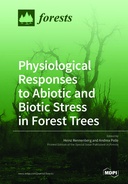Explore

Physiological Responses to Abiotic and Biotic Stress in Forest Trees
Heinz Rennenberg and Andrea Polle
2019
0 Ungluers have
Faved this Work
Login to Fave
As sessile organisms, plants have to cope with a multitude of natural and anthropogenic forms of stress in their environment. Due to their longevity, this is of particular significance for trees. As a consequence, trees develop an orchestra of resilience and resistance mechanisms to biotic and abiotic stresses in order to support their growth and development in a constantly changing atmospheric and pedospheric environment. The objective of this Special Issue of Forests is to summarize state-of-art knowledge and report the current progress on the processes that determine the resilience and resistance of trees from different zonobiomes as well as all forms of biotic and abiotic stress from the molecular to the whole tree level.
This book is included in DOAB.
Why read this book? Have your say.
You must be logged in to comment.
Rights Information
Are you the author or publisher of this work? If so, you can claim it as yours by registering as an Unglue.it rights holder.Downloads
This work has been downloaded 332 times via unglue.it ebook links.
- 68 - pdf (CC BY-NC-ND) at Unglue.it.
Keywords
- 24-epiBL application
- ?13C
- Abies alba Mill.
- abiotic stress
- Aleppo pine
- antioxidant activity
- antioxidant enzyme activity
- antioxidant enzymes
- bamboo forest
- basal area increment
- Ca2+ signal
- canopy conductance
- Carpinus betulus
- Carpinus turczaninowii
- chloroplast ultrastructure
- Climate
- cold stress
- defense response
- della
- differentially expressed genes
- Disturbance
- drought
- drought stress
- Ecophysiology
- elevation gradient
- Expression
- Fagus sylvatica L.
- forest type
- Fraxinus mandshurica Rupr.
- Functional analysis
- GA-signaling pathway
- gas exchange
- gene regulation
- glutaredoxin
- Greece
- Growth
- Heterobasidion annosum
- Heterobasidion parviporum
- History of engineering & technology
- hydrophilic polymers
- Infection
- intrinsic water-use efficiency
- ion contents
- ion homeostasis
- ion relation
- ion relationships
- Konjac glucomannan
- leaf properties
- living cell
- long-term drought
- Luquasorb
- malondialdehyde
- mid-term
- mixed stands
- Molecular cloning
- morphological indices
- Moso Bamboo (Phyllostachys edulis)
- N nutrition
- n/a
- non-structural carbohydrate
- Norway spruce
- Nutrition
- organic osmolytes
- osmotic adjustment substances
- pathogen
- Photosynthesis
- photosynthetic responses
- physiological response
- Pinus koraiensis Sieb. et Zucc.
- Pinus massoniana
- plant tolerance
- plasma membrane Ca2+ channels
- Populus euphratica
- Populus simonii Carr. (poplar)
- Proline
- pure stands
- Reactive Oxygen Species
- Robinia pseudoacacia L.
- rubber tree
- salicylic acid
- Salinity
- salinity treatments
- salt stress
- sap flow
- signal network
- silicon fertilization
- soil N
- soluble sugar
- starch
- Stockosorb
- subcellular localization
- tapping panel dryness
- TCP
- Technology, engineering, agriculture
- Technology: general issues
- tree
- tree rings
- water availability
- water potential
- water relations
- wood formation
Links
DOI: 10.3390/books978-3-03921-515-7Editions


